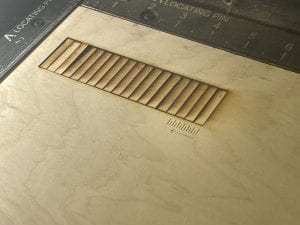This project seemed very simple at first. I had previously used the laser cutter, so I was very familiar with the set up and operation of the laser cutter. I used the website in the canvas document to create the 4″x 4″x 4″ box and set the finger size to 0.60475 inches. Using calipers, we were able to find that our material was 0.21″ thick and we set the box software accordingly.
After this, we went to find the appropriate kerf value. To do this, we cut 10 strips of wood out and measured the difference in width between the original rectangle and the strips. This can be seen below. We found the width to be 0.1535 inches and then dividing this by 20 (# cuts) to find that the kerf was around 0.007″.

We then cut two of the six wood faces of the box to test the fit with 0.007″ kerf. This fit was really tight, but one could hammer the wood into place so it was flush. This is the approach my partner took during the process. I decided to go with a lower kerf of 0.006″ so the joints wouldn’t be so tight. I then cut 4 panels with tape over the top in order to avoid residual wood burning on the surface and then cut the last two panels with the engraved images. The cut settings I had were: [10f, 4s, 100p] for vector and [100s, 70p] for raster. I saw my partner’s example of etching with 100s and 80p, but I personally prefer a lighter etching for the Duncan logo. This led to the following box that was assembled with the help of a mallet:




Overall, this project was interesting and didn’t require too much time. If I were to do this project again, I would try a lower kerf value in order to make fitting the box easier. I had to use a mallet and hammer the edges in so they fit snuggly. A hand fitting would have made my life easier. Another issue that one can see with my box is that there is a small crack on one of the corners. This occurred after I accidentally dropped my box. The tight kerf made the crack a little worse, but the main damage occurred from an accident. Issues like this are another reason I would make the kerf smaller. The crack can be seen below:

The cost breakdown of this project is:
Time: 2hrs –> ~$20
Materials: One 1/4″ wood sheet for 2 boxes –> ~$1.40
Masking tape –> ~$0.20
Energy costs would factor into this equation, but there is not an easy way to estimate this cost. Therefore the cost is around $21.60 per box if one is paying the employees $10 / hr.
